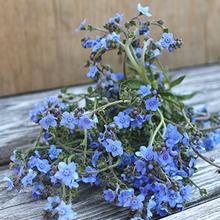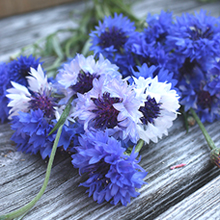- 3 Easy, Reliable, Productive Cut Flowers: Sunflowers, Zinnias & Rudbeckia
- 5 Factors That Determine Vase Life of Cut Flowers
- American Flowers Week: Combining the Art of Floral Design & Couture
- Celebrate the 7th American Flowers Week | Johnny's 2021 Botanical Couture
- Celebrating the 8th American Flowers Week | Johnny's 2022 Botanical Couture
- Collective Selling Models for Flower Farmers: Flower Hubs That Work
- 5 Cool Flowers to Plant Now | Lisa Mason Ziegler's Secrets for Growing Hardy, Cool-Season Annuals
- Cut-Flower Harvesting & Post-Harvest Care | Best Practices from Pros in the Slow Flower Community
- Cut-Flower Kit | Guide for Market Growers (PDF)
- Easy Cut-Flower Garden Map | For Growers New to Flowers (PDF)
- Easy Cut-Flower Garden Planner | For Growers New to Flowers (PDF)
- From Color to Climate: 5 Floricultural Trends Subtle & Seismic
- Flower Culture by Crop | Comparison Chart | Days to Germination, Weeks to Transplant, Days to Harvest (PDF)
- Flower Farmers' Favorite Fillers & Foliage | Recommendations from 3 Farmer-Florists
- Getting Started in Cut-Flowers | Top 15 Cuts
- Heat & Drought: How Flower Farmers Are Adapting to Changing & Challenging Climatic Conditions
- Intro to Overwintering Flowers | Method & Recommendations from Johnny's Overwinter Flower Trials
- An Introduction to Producer Marketing Cooperatives | M Lund & Associates
- How Day Length Affects Cut-Flower Production
- Flower Power for Roadside Markets
- Growing Flowers in Hoophouses & High Tunnels: Some Cool-Weather & Hot-Weather Options
- Tips for Starting a U-Pick Flower Operation
- Year-Round Flower Production Strategy
- Overwinter Flower Trials | Multiyear Results for >25 Crops | Johnny's Selected Seeds | XLSX
- Seeding Date Calculator | Johnny's Recommended Flowers for Overwintering | XLSX
- Sustainable Farming Methods | A Survey of Flower Farmers' Best Practices
- Just Add Flowers | An Introduction to Companion Planting for Vegetable & Herb Gardeners
- Pricing & Profitability for Flower-Farmers | Pointers from a Diversity of Pros
- Slow Flowers Palette & Petal Crushes | Evolving Colors & Shape-Shifts in Floral Industry Trends
- Johnny's & Slow Flowers | Johnny's Selected Seeds
- Slow Flowers | Celebrating Fifth-Season Regional Design Elements
- Slow Flowers Floral Forecast | A Summary of Industry Insights & Trends
- Slow Flowers | Building a Better Market Bouquet | Tips & Techniques for Flower Farmers
- Slow Flowers | Tips for Staging On-Farm Floral Workshops | Johnny's Selected Seeds
- Wedding Wisdom 101 | 10 Beginner Tips for Entering the Wedding Floral Landscape
- Succession-Planting Flowers | Scheduling & Planning, Sowing Frequency, Recordkeeping & Recommendations
- Succession-Planting Interval Chart for Flowers
- Sustainable Floral Design | Techniques & Mechanics for Foam-Free Floristry | Tobey Nelson & Debra Prinzing
- Video: Mason Jar Bouquet Tutorial
- Video: How to Build a Bouquet
- Video: Tobey Nelson | Sustainable Floral Design | Slow Flowers Summit
- Video: Economic Considerations in Overwintering Cut Flowers | Johnny's Selected Seeds
- Floral Stem Cutter | Instructions for Mounting, Use & Care | Tech Sheet (PDF)
- Top-10 Flowers for Direct-Seeding | 5 for Cool-Soil Sowing + 5 for Warm-Soil Sowing
- Video: Floating Row Cover | Baby "Cool Flower" Protection from Whipping Winter Winds
- Video: The Procona System for All-in-one Flower Harvest, Transport & Display
- Johnny's Overwinter Flowers Tunnel: Trellising, Supports, Ground Cover & Spacing
- Video: Irrigation Considerations for the Overwinter Flowers Tunnel | Johnny's Selected Seeds
- Video: Johnny's Overwinter Flowers Trial Recap
- Video: Producer Cooperatives for Small-Scale Farmers | Johnny's Webinar Series
- Climate Adaptation for Vegetable & Flower Farmers | Johnny's Educational Webinar Resources
- Bloom to Boom: Flower Farm Profitability
- Choosing Tulip Varieties for Forcing
- Forcing Tulip Bulbs
- Flowering in the South: Profiles of 5 flower farmers who cope with temperature, humidity, pest & weed pressure
- Video: Flower Growing in Southern States | Johnny's Webinar Series
- 10 Tips for Building a Profitable Cut-Flower Business
- Introduction to Forcing Flower Bulbs in Soil
- Eat Your Flowers: Serve Up That Wow Factor With Edible Flowers
- Flower Growing in Southern States | Johnny's Educational Webinar Series
- Edible Flowers List: Top 20 Favorites from the Slow Flowers Community
- Choosing Flower Crops to Overwinter: Results from Our Trials
- Chrysal Clear Universal Flower Conditioner | SDS
- Chrysal Classic Professional 2 Transport & Display (Holding) Solution | SDS
- Chrysal Professional 2 Transport & Display T-Bag | SDS
- Chrysal Clear Bulb Flower Conditioner | SDS
- Webinar Slide Deck | New-for-2023 Flowers & Floral Supplies | PDF
- Chrysal CVBN Flower Conditioner | SDS
- Chrysal Clear Bulb T-Bag | Cut-Flower Conditioner | SDS
- Chrysal Professional 1 Hydration Solution | SDS
- Chrysal Professional 3 Vase Solution Powder | SDS
- Webinar Slide Deck | Flower Growing in Southern States | PDF
- When to Start Seeds for Overwintered Flowers
A Favorite Weekly Ritual
with Johnny's Flower Product Manager, Hillary Alger
Simple Tips for an Effortless Look
Filling a Mason jar with seasonal blooms and branches is a favorite weekly ritual. It's amazing how the diversity of flora can change in just a week's time throughout the growing season. Whether it is blossoms, fruits, herbs, or vegetables, taking a little time to collect and reflect on the season's offering heightens our awareness of time, place, and seasonal rhythms.
Here are a few tips for collecting and arranging this simple bouquet.
Design Tips
1. Before cutting
|
|
2. Start with the sturdiest
|
|
3. Crisscross the stems
|
|
4. Complete the base
|
|
5. Fill it in.
|
|
6. Small pieces.
|
|
7. Finishing touches
|
Enjoy…
A larger jar (quart) will hold more water, requiring less frequent replenishment. We got a little carried away, stuffing our jar with so many beautiful blooms!








